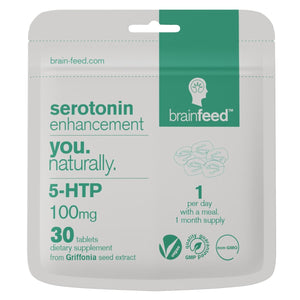Is 5-htp natural? Boost your feel-good chemical with nature’s gifts
filter
5-htp is a popular supplement as it’s the building block of your feel-good chemical serotonin which helps you regulate mood and sleep. With its rise in popularity, questions about the supplement are beginning to arise: Is 5-htp natural? Is 5-htp safe? Whilst the short answer is yes, this article answers those questions to paint a clear picture of 5-htp and its occurrence in nature.
Watch this video to discover how to increase Serotonin naturally:
Serotonin: your feel-good chemical
Your feel-good chemical serotonin is an important brain messenger and hormone that mediates a range of physiological function[1 Trusted Source 2020 - The International Journal of Biochemistry & Cell Biology Research evaluation The ever-changing roles of serotonin ] . It is usually paired together with dopamine, oxytocin, and endorphins that form the so-called happiness chemicals. Serotonin can get released when you’re out in the sunlight, while exercising, getting a massage or remembering happy events[2 Trusted Source 2017 - Psychology Today 3rd-party source Boosting Your Serotonin Activity ] . When that happens, serotonin regulates your emotions, such as your mood and temperament in the frontal part of your brain[3 Trusted Source 2006 - American Journal of Psychiatry Research evaluation Serotonin ] . When your serotonin levels are normal, you feel more emotionally stable and happier[4 Trusted Source 2022 - Cleveland Clinic 3rd-party source Serotonin ] . Serotonin also regulates sleep. The more normal your serotonin levels are, the better and longer you’ll sleep[4 Trusted Source 2022 - Cleveland Clinic 3rd-party source Serotonin ] . Your brain also needs serotonin to make your sleep hormone melatonin which regulates your sleep-wake cycle. You can read more about it here.
What comes first? Tryptophan, 5-htp and serotonin
As described above, serotonin is a chemical messenger in your brain. It can only get released if it has been produced in your brain. But how does that happen?

We ingest a nutrient that is needed for the production of messengers in the brain called tryptophan[5 Trusted Source National Library of Medicine 3rd-party source Tryptophan ] . Tryptophan is a so-called essential amino acid which means your body has to get it from your diet instead of making it itself[5 Trusted Source National Library of Medicine 3rd-party source Tryptophan ] . When tryptophan is in your body it starts competing with other molecules to be picked up by a special transporter[6 Trusted Source 2016 - Nutrients Research evaluation Influence of Tryptophan and Serotonin on Mood and Cognition with a Possible Role of the Gut-Brain Axis ] . The transporter allows tryptophan to enter the brain from the blood[6 Trusted Source 2016 - Nutrients Research evaluation Influence of Tryptophan and Serotonin on Mood and Cognition with a Possible Role of the Gut-Brain Axis ] . There, another molecule joins tryptophan and together they transform into the direct building block of serotonin, called 5-htp[6 Trusted Source 2016 - Nutrients Research evaluation Influence of Tryptophan and Serotonin on Mood and Cognition with a Possible Role of the Gut-Brain Axis ] . So, serotonin can only be produced if your brain gets the right amount of 5-htp. For example, if your body transported just a small amount of tryptophan into your brain which was then converted into 5-htp, your serotonin levels will stay low even if you exercise or stay outside in the sunshine. So, what is 5-htp made from?
Getting enough 5-htp through a tryptophan-rich diet
You can get the recommended daily dose of 5-htp through adequate tryptophan intake. Tryptophan is found in protein-rich foods. The World Health Organization published the Protein and amino acid requirements in human nutrition manual in 2007[7 Trusted Source 2020 - NHS Digital 3rd-party source https://files.digital.nhs.uk/9D/4195D5/HSE19-Overweight-obesity-rep.pdf ] . According to the manual, the recommended daily intake of tryptophan is 4 mg per 1 kg of human weight per day. An NHS 2019 study found that the average weight was 72.1 kg for women and 85.4 kg for men[8 Trusted Source 2007 - WHO Technical Report Series 3rd-party source Protein and amino acid requirements in human nutrition ] . Therefore, UK women and men should ingest somewhere between 290 and 240 mg of tryptophan per day. Now take a look at how much tryptophan you can find in 100 g of different plant-based foods.
|
Tryptophan in 100g of food (in mg) |
|
|
Edamame |
195 |
|
Chia Seeds |
124 |
|
Hemp Seeds |
105 |
|
Flax Seeds |
84 |
|
Raw Cashews |
82 |
|
Raw Peanuts |
71 |
|
Avocados |
50 |
|
Cremini Mushrooms |
49 |
|
Kiwifruit |
27 |
|
Apricots |
23 |
With a typical Western diet, people usually ingest around 500 mg of tryptophan per day[9 Trusted Source Accurate Clinic 3rd-party source L-tryptophan & 5-HTP (5-Hydroxytryptophan) ] . Due to tryptophan’s competition with other amino acids to win over the transporter molecule, only 2–3% of tryptophan enters the brain where it is converted into 5-htp and then into serotonin[6 Trusted Source 2016 - Nutrients Research evaluation Influence of Tryptophan and Serotonin on Mood and Cognition with a Possible Role of the Gut-Brain Axis ] , [9 Trusted Source Accurate Clinic 3rd-party source L-tryptophan & 5-HTP (5-Hydroxytryptophan) ] . 100mg daily of 5-htp has shown positive effects on mood and sleep regulation. If you do the quick math that means you should ingest around 13-14 times the usual tryptophan intake in the typical Western diet for it to be converted into the recommended daily amount of 5-htp.
Natural sources of 5-htp
Another way to get the recommended daily dose of 5-htp is directly from a natural source. There are a few 5-htp sources known as of today although it is hard to ingest them in an adequate amount naturally.
Studies showed 5-htp can be found in some mushrooms (White bottom mushroom, Honey mushroom, Bay bolete mushroom and porcini mushroom just to name a few), weed couch grass, quack grass, St. John’s wort (when planted in a very specific way) and intertidal sea sponge in very small doses[10 Trusted Source 2022 - Foods Research evaluation Edible Mushrooms as a Potential Component of Dietary Interventions for Major Depressive Disorder ] , [11 Trusted Source 2021 - International Journal of Molecular Sciences Research evaluation 5-Hydroxytryptophan (5-HTP): Natural Occurrence, Analysis, Biosynthesis, Biotechnology, Physiology and Toxicology ] , [12 Trusted Source 2013 - Mycoscience 3rd-party resource Levels of physiologically active indole derivatives in the fruiting bodies of some edible mushrooms (Basidiomycota) before and after thermal processing ] . A fairly new study conducted in Brazil also showed that 5-htp is present in Brazilian honey[13 Trusted Source 2022 - Melatonin Research 3rd-party resource Serotonin, melatonin and their precursors and metabolites and vitamin D3 derivatives in honey ] . However, the detection of 5-htp in the study and 5-htp concentrations depended on seasons, year, flowering, and climate[13 Trusted Source 2022 - Melatonin Research 3rd-party resource Serotonin, melatonin and their precursors and metabolites and vitamin D3 derivatives in honey ] , [14 Trusted Source 2022 - International journal of tryptophan research Animal study Tryptophan and Biogenic Amines in the Differentiation and Quality of Honey ] . Griffonia Simplicifolia seeds are the largest source of 5-htp[15 Trusted Source 2022 - Examine 3rd-party source Griffonia Simplicifolia ] , [16 Trusted Source 2017 - Rutgers University 3rd-party source A phytochemical exploration of Griffonia simplicifolia seeds and leaves ] . One seed contains up 6.37% of 5-htp by weight[15 Trusted Source 2022 - Examine 3rd-party source Griffonia Simplicifolia ] . Below, you can see the amounts of 5-htp in 100g of certain sources.
|
5-htp in 100g of source (in mg) |
The amount of ingested source to reach 100mg of 5-htp |
|
|
White bottom mushroom |
<0.001 |
100 kg |
|
Honey mushroom |
<0.001 |
100 kg |
|
Bay bolete mushroom |
<0.001 |
100 kg |
|
Porcini mushroom |
0.18 |
55 kg |
|
Brazilian honey |
2 |
5 kg |
It’s fair to say that getting an adequate intake of 5-htp from most of the above-mentioned natural sources would be almost impossible and definitely unhealthy as high amounts of those natural sources contain other compounds which can be toxic when ingested in big amounts.
5-htp natural supplement
If you’re looking to supplement 5-htp you can opt for brain feed’s high-quality serotonin enhancement product.
So, what is in 5-htp? 5-htp is just one of the compounds found in Griffonia seeds, therefore, it has to be extracted. The 5-htp in brain feed’s 5-htp 100 mg tablets is extracted and isolated from Ghanian Griffonia Simplicifolia seeds. 98% of the tablet is comprised of 5-htp making it the smallest, nutrient-dense tablet available without including unnecessary bulking agents. 100 mg 5-htp per tablet is a high-quality and high-strength product. You should start by taking only 1 tablet with a meal. You can take a maximum of 2 tablets of 5-htp per day. 200 mg of 5-htp and more per day have been safely taken for up to one year. brain feed recommends taking 5-htp when you have an emotional need for the product. All new customers get 15% off their first purchase when using the code ‘NEW15’ at the checkout.
With all the questions answered you’re encouraged to be mindful of your tryptophan and 5-htp intake so you can better regulate your mood and sleep.
References
[1] Jones, L. A., Sun, E. W., Martin, A. M., & Keating, D. J. (2020). The ever-changing roles of serotonin. The International Journal of Biochemistry & Cell Biology, 125, 105776. https://www.sciencedirect.com/science/article/abs/pii/S1357272520300935?via%3Dihub
[2] Korb, A. (2017). Boosting Your Serotonin Activity. Psychology Today. https://www.psychologytoday.com/intl/blog/prefrontal-nudity/201111/boosting-your-serotonin-activity#:~:text=The%20four%20ways%20to%20boost,a%20more%20in%2Ddepth%20look.
[3] Hariri, A. R., & Brown, S. M. (2006). Serotonin. American Journal of Psychiatry, 163(1), 12–12. https://psychiatryonline.org/doi/10.1176/appi.ajp.163.1.12
[4] Serotonin (2022). Cleveland Clinic. https://my.clevelandclinic.org/health/articles/22572-serotonin#:~:text=Mood%3A%20Serotonin%20in%20your%20brain,serotonin%20are%20associated%20with%20depression.
[5] Tryptophan (n.d.). National Library of Medicine. https://medlineplus.gov/ency/article/002332.htm#:~:text=Tryptophan%20is%20an%20amino%20acid,get%20it%20from%20your%20diet.
[6] Jenkins, T. A., Nguyen, J. C. D., Polglaze, K. E., & Bertrand, P. P. (2016). Influence of Tryptophan and Serotonin on Mood and Cognition with a Possible Role of the Gut-Brain Axis. Nutrients, 8(1), 56. https://www.mdpi.com/2072-6643/8/1/56
[7] Moody, A. (2020). Health Survey for England 2019 Overweight and obesity in adults and children. NHS Digital. https://files.digital.nhs.uk/9D/4195D5/HSE19-Overweight-obesity-rep.pdf
[8] The World Health Organization. (2007). Protein and amino acid requirements in human nutrition manual. WHO Technical Report Series. http://apps.who.int/iris/bitstream/handle/10665/43411/WHO_TRS_935_eng.pdf
[9] L-tryptophan & 5-HTP (5-Hydroxytryptophan) (n.d.). Accurate Clinic. https://accurateclinic.com/accurate-education-l-tryptophan-5-htp-5-hydroxytryptophan/#:~:text=The%20typical%20Western%20diet%20contains,HTP
[10] Fijałkowska, A., Jędrejko, K., Sułkowska-Ziaja, K., Ziaja, M., Kała, K., & Muszyńska, B. (2022). Edible Mushrooms as a Potential Component of Dietary Interventions for Major Depressive Disorder. Foods, 11(10), Article 10. https://www.mdpi.com/2304-8158/11/10/1489
[11] Maffei, M. E. (2021). 5-Hydroxytryptophan (5-HTP): Natural Occurrence, Analysis, Biosynthesis, Biotechnology, Physiology and Toxicology. International Journal of Molecular Sciences, 22(1), Article 1. https://www.mdpi.com/1422-0067/22/1/181
[12] Muszyńska, B., Sułkowska-Ziaja, K., & Wójcik, A. (2013). Levels of physiologically active indole derivatives in the fruiting bodies of some edible mushrooms (Basidiomycota) before and after thermal processing. Mycoscience, 54(5), 321–326. https://www.jstage.jst.go.jp/article/mycosci/54/5/54_MYC54321/_article/-char/en
[13] Kim, T.-K., Fabisiak, A., Brzeminski, P., Reiter, R. J., & Slominski, A. T. (2022). Serotonin, melatonin and their precursors and metabolites and vitamin D3 derivatives in honey. Melatonin Research, 5(3), 374–380. https://www.melatonin-research.net/index.php/MR/article/view/205
[14] Borges, C. V., Nunes, A., Costa, V. E., Orsi, R. de O., Basilio, L. S. P., Monteiro, G. C., Maraschin, M., & Lima, G. P. P. (2022). Tryptophan and Biogenic Amines in the Differentiation and Quality of Honey. International Journal of Tryptophan Research, 15, 11786469221102098. https://journals.sagepub.com/doi/10.1177/11786469221102098
[15] Adotey, A., & Nii, J. (2009). Local production of 5-HTP from the seeds of griffonia simplicifolia [Master's thesis, Faculty of Pharmacy and Pharmaceutical Sciences College of Health Sciences, Kwame Nkrumah University of Science and Technology]. https://ir.knust.edu.gh/handle/123456789/92
[16] Giurleo, D. (2017). A phytochemical exploration of Griffonia simplicifolia seeds and leaves [Master Thesis]. Graduate School-New Brunswick Rutgers, The State University of New Jersey. https://rucore.libraries.rutgers.edu/rutgers-lib/52205/


 alertness
alertness
 cognition
cognition
 sleep
sleep
 wellbeing
wellbeing









Leave a comment
Open tab